
The Thomisidae are a family of spiders, including about 170 genera and over 2,100 species. The common name crab spider is often linked to species in this family, but is also applied loosely to many other families of spiders. Many members of this family are also known as flower spiders or flower crab spiders.
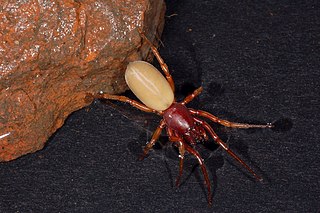
Dysderidae, also known as woodlouse hunters, sowbug-eating spiders, and cell spiders, is a family of araneomorph spiders first described by Carl Ludwig Koch in 1837. They are found primarily in Eurasia, extending into North Africa with very few species occurring in South America. Dysdera crocata is introduced into many regions of the world.
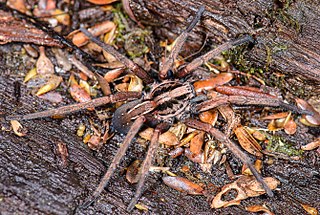
Miturgidae is a family of araneomorph spiders that includes nearly 170 species in 29 genera worldwide. First described by Eugène Simon in 1886, it has been substantially revised, and includes the previous family Zoridae as a synonym, and excludes the family Xenoctenidae. Several genera have also been removed, such as the large genus Cheiracanthium, which was transferred to the Cheiracanthiidae.

Avicularia is a genus of the family Theraphosidae containing various species of arboreal tarantulas. The genus is native to Panama, the Caribbean, and tropical South America. Each species in the genus has very distinguishable pink foot pads.
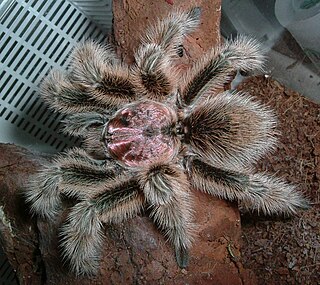
Grammostola is a genus of South American tarantulas that was first described in text by Eugène Louis Simon in 1892. These medium- to large-sized spiders are native to tropical South America, and are usually brown in color, with pinkish or orangish-red hairs. The very docile Chilean rose tarantula is popular as a beginner's spider among tarantula enthusiasts.

Actinopodidae is a family of mygalomorph spiders found in mainland Australia and South America usually in open forest. Species are most common in Queensland, Australia. It includes mouse spiders, whose bites, though rare, are considered medically significant and potentially dangerous.
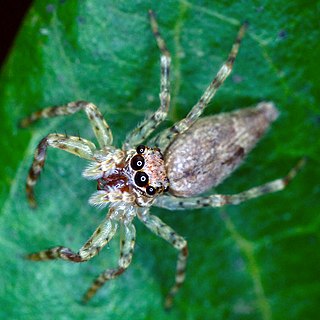
Helpis is a genus of the spider family Salticidae.

Actinopus is a genus of mygalomorph spiders in the family Actinopodidae. It was first described by Josef Anton Maximilian Perty in 1833 from the type species Actinopus tarsalis found in Brazil. The name is derived from Greek actin- "ray, beam" and pous "foot". It is a senior synonym of Aussereria, Closterochilus, Pachyloscelis, and Theragretes.

Peucetia is a genus of lynx spiders that is found worldwide.

Iridopelma is a genus of Brazilian tarantulas that was first described by Reginald Innes Pocock in 1901.

Missulena insignis, commonly known as the lesser red-headed mouse spider, is a species of spider belonging to the family Actinopodidae native to Australia. The species name is derived from the Latin insignis "mark".
Kochiana is a monotypic genus of Brazilian tarantulas containing the single species, Kochiana brunnipes or the dwarf pink leg. It was first described by C. L. Koch in 1841 under the name "Mygale brunnipes", and was transferred to its own genus in 2008. As of April 2020, it has only been found in Brazil.

Stasimopus is a genus of African mygalomorph spiders that was first described by Eugène Louis Simon in 1892. It is the only genus in the family Stasimopidae.

Corinna is a genus of corinnid sac spiders first described by Carl Ludwig Koch in 1841. They are found in Mexico and south to Brazil, and with selected species found in Africa.

Geolycosa is a genus of wolf spiders first described in 1904.

Caribena is a genus of spiders in the family Theraphosidae (tarantulas), found in the Antilles. The two species accepted as of March 2017 were formerly placed in Avicularia. Apart from a different distribution – Avicularia species are found in mainland South and Central America – Caribena is distinguished by having longer and thinner type II urticating hairs in a conspicuous patch on the upper surface of the abdomen. Males also have a differently shaped palpal bulb.
Pionidae is a family of prostigs in the order Trombidiformes. There are about 15 genera and at least 90 described species in Pionidae.
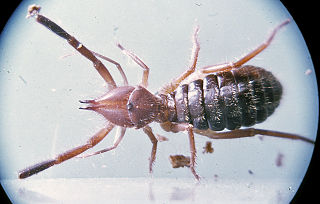
Gluvia is a genus of daesiid camel spiders, first described by Carl Ludwig Koch in 1842. It only has two species, Gluvia dorsalis and Gluvia brunnea, the only two species of solifugid found in Portugal and Spain. Gluvia dorsalis is reported to be a common species on the streets of Madrid.
Actinopus reznori is a species of mygalomorph spider in the family Actinopodidae. It can be found in the states of São Paulo, Rio de Janeiro and Bahia, Brazil. Actinopus reznori has a dark black body with legs averaging about 2 inches, and large round thorax.















